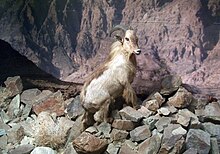Arabian tahr
| Arabian Tahr | |
|---|---|
 |
|
| Scientific classification | |
| Kingdom: | Animalia |
| Phylum: | Chordata |
| Class: | Mammalia |
| Order: | Artiodactyla |
| Family: | Bovidae |
| Subfamily: | Caprinae |
| Genus: |
Arabitragus Ropiquet & Hassanin, 2005 |
| Species: | A. jayakari |
| Binomial name | |
|
Arabitragus jayakari (Thomas, 1894) |
|
| Synonyms | |
|
Hemitragus jayakari |
|
Hemitragus jayakari
The Arabian tahr (Arabitragus jayakari) is a species of tahr native to Arabia. Until recently, it was placed in the genus Hemitragus, but genetic evidence supports its removal to separate monotypic genus.
The Arabian tahr is the smallest species of tahr. The animal is of stocky build with backward-arching horns in both sexes. Males are much more robust than females. Its coat consists of a long, reddish-brown hair, with a dark stripe running down the back. Males possess the most impressive manes which extend right down the back and grow longer, based on the age. In the oldest males the muzzle darkens to black and the eye stripes also darken. As with most mountain goats and sheep, it has rubbery hooves to provide balance and traction on the steep, rocky slopes.
The Arabian tahr lives on steep rocky slopes of Hajar Mountains in the Sultanate of Oman, and the United Arab Emirates at altitudes of up to 1,800 meters above sea level.
The species was first described from specimens obtained by Dr. A.S.G. Jayakar from Jebel Taw and originally given the name of Hemitragus jayakari. It was separated into the newly created genus Arabitragus on the basis of a study on the molecular phylogeny of the group in 2005.
Unlike other species of tahr, the Arabian tahr is solitary or lives in small groups consisting of a female and a kid, or a male. And instead of forming herds during seasonal ruts, reproduction occurs in small, dispersed family units. There are reports of births occurring throughout the year, and gestation lasts from 140–145 days.
These animals are usually browsers, feeding on grass, shrubs, leaves, and fruits of most trees. They are highly dependent on water and need to drink every two or three days during summer. They would descend from their point of elevation to drink from river courses known as wadis, and would travel to new areas when water dries up.
...
Wikipedia

